Advance math how do i solve this problem, I'm really confused?
(tan^2 x + 1)(cos ^ 2 x - 1) = sec ^ 2 x (-sin ^ 2 x)
(tan^2 x + 1)(cos ^ 2 x - 1) = sec ^ 2 x (-sin ^ 2 x)
2 Answers
Explanation:
See below.
Explanation:
This is called an identity. It means that the expression on the left is equal to the expression on the right for all
What you have to do here is, prove this by manipulating one side so as to get the same expression as the other side. Looking at this one I would start manipulating the left hand side.
Using identities:
1)
2)
3)
Using identities 1 and 2:
Add the terms in the first bracket:
Using identity 1
By identity 3:
So we have proved that this is true.
What we are doing is proving an identity by using other known identities.
In order to solve these you must know the common trig identities. You can find them in most text books aimed at this level or online. It is best to write them down on a sheet of paper so as to learn them. It takes a while to memorise them, so having them written down is really useful.


